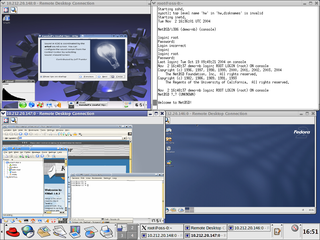Related Research Articles

Xen is a free and open-source type-1 hypervisor, providing services that allow multiple computer operating systems to execute on the same computer hardware concurrently. It was originally developed by the University of Cambridge Computer Laboratory and is now being developed by the Linux Foundation with support from Intel, Citrix, Arm Ltd, Huawei, AWS, Alibaba Cloud, AMD, Bitdefender and epam.

Free and Open source Software Developers' European Meeting (FOSDEM) is a non-commercial, volunteer-organized European event centered on free and open-source software development. It is aimed at developers and anyone interested in the free and open-source software movement. It aims to enable developers to meet and to promote the awareness and use of free and open-source software.
Wind River Systems, also known as Wind River, is an Alameda, California–based company, subsidiary of Aptiv PLC. The company develops embedded system and cloud software consisting of real-time operating systems software, industry-specific software, simulation technology, development tools and middleware.
OS-level virtualization is an operating system (OS) virtualization paradigm in which the kernel allows the existence of multiple isolated user space instances, called containers, zones, virtual private servers (OpenVZ), partitions, virtual environments (VEs), virtual kernels, or jails. Such instances may look like real computers from the point of view of programs running in them. A computer program running on an ordinary operating system can see all resources of that computer. However, programs running inside of a container can only see the container's contents and devices assigned to the container.
Vyatta is a software-based virtual router, virtual firewall and VPN product for Internet Protocol networks. A free download of Vyatta has been available since March 2006. The system is a specialized Debian-based Linux distribution with networking applications such as Quagga, OpenVPN, and many others. A standardized management console, similar to Juniper JUNOS or Cisco IOS, in addition to a web-based GUI and traditional Linux system commands, provides configuration of the system and applications. In recent versions of Vyatta, web-based management interface is supplied only in the subscription edition. However, all functionality is available through KVM, serial console or SSH/telnet protocols. The software runs on standard x86-64 servers.

The Linux Foundation (LF) is a non-profit organization established in 2000 to support Linux development and open-source software projects.

RAD is a privately held corporation, headquartered in Tel Aviv, Israel that designs and manufacturers specialized networking equipment.
In computing, network virtualization is the process of combining hardware and software network resources and network functionality into a single, software-based administrative entity, a virtual network. Network virtualization involves platform virtualization, often combined with resource virtualization.

Linux Containers (LXC) is an operating-system-level virtualization method for running multiple isolated Linux systems (containers) on a control host using a single Linux kernel.
6WIND is a virtual networking software company delivering disaggregated and cloud-native solutions to CSPs and enterprises globally. The company is privately held and headquartered in the West Paris area, in Montigny-le-Bretonneux. 6WIND has a global presence with offices in the US and APAC. The company provides virtualized networking software which is deployed in bare-metal or in virtual machines on COTS servers in public & private clouds. Their solutions are disaggregated and containerized based on the cloud-native architecture.
Software-defined networking (SDN) is an approach to network management that enables dynamic and programmatically efficient network configuration to improve network performance and monitoring in a manner more akin to cloud computing than to traditional network management. SDN is meant to improve the static architecture of traditional networks and may be employed to centralize network intelligence in one network component by disassociating the forwarding process of network packets from the routing process. The control plane consists of one or more controllers, which are considered the brains of the SDN network, where the whole intelligence is incorporated. However, centralization has certain drawbacks related to security, scalability and elasticity.
Linux on IBM Z or Linux on zSystems is the collective term for the Linux operating system compiled to run on IBM mainframes, especially IBM Z / IBM zSystems and IBM LinuxONE servers. Similar terms which imply the same meaning are Linux/390, Linux/390x, etc. The three Linux distributions certified for usage on the IBM Z hardware platform are Red Hat Enterprise Linux, SUSE Linux Enterprise Server, and Ubuntu.
Network functions virtualization (NFV) is a network architecture concept that leverages IT virtualization technologies to virtualize entire classes of network node functions into building blocks that may connect, or chain together, to create and deliver communication services.

The OpenDaylight Project is a collaborative open-source project hosted by the Linux Foundation. The project serves as a platform for software-defined networking (SDN) for customizing, automating and monitoring computer networks of any size and scale.

Open vSwitch, sometimes abbreviated as OVS, is an open-source implementation of a distributed virtual multilayer switch. The main purpose of Open vSwitch is to provide a switching stack for hardware virtualization environments, while supporting multiple protocols and standards used in computer networks.

Mirantis Inc. is a Campbell, California, based B2B open source cloud computing software and services company. Its primary container and cloud management products, part of the Mirantis Cloud Native Platform suite of products, are Mirantis Container Cloud and Mirantis Kubernetes Engine. The company focuses on the development and support of container and cloud infrastructure management platforms based on Kubernetes and OpenStack. The company was founded in 1999 by Alex Freedland and Boris Renski. It was one of the founding members of the OpenStack Foundation, a non-profit corporate entity established in September, 2012 to promote OpenStack software and its community. Mirantis has been an active member of the Cloud Native Computing Foundation since 2016.

Albert Greenberg is an American software engineer and computer scientist who is notable for his contributions to the design of operating carrier and datacenter networks as well as to advances in computer networking and cloud computing. He currently serves as Vice President of Platform Engineering at Uber.
Microsoft, a technology company historically known for its opposition to the open source software paradigm, turned to embrace the approach in the 2010s. From the 1970s through 2000s under CEOs Bill Gates and Steve Ballmer, Microsoft viewed the community creation and sharing of communal code, later to be known as free and open source software, as a threat to its business, and both executives spoke negatively against it. In the 2010s, as the industry turned towards cloud, embedded, and mobile computing—technologies powered by open source advances—CEO Satya Nadella led Microsoft towards open source adoption although Microsoft's traditional Windows business continued to grow throughout this period generating revenues of 26.8 billion in the third quarter of 2018, while Microsoft's Azure cloud revenues nearly doubled.
A cloud-native network function (CNF) is a software-implementation of a function, or application, traditionally performed on a physical device, but which runs inside Linux containers. The features that differ CNFs from VNFs, one of the components of network function virtualization, is the approach in their orchestration.
References
- ↑ Dan Meyer (30 September 2014). Linux Foundation launches reference platform for ‘carrier-grade’ NFV. RCR Wireless News. Accessed April 2015.